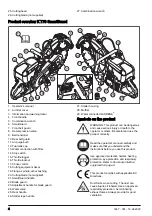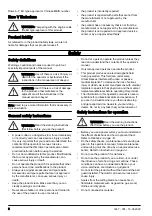
Dust safety
WARNING: Read the warning instructions
that follow before you use the product.
• Operation of the product can cause dust in the air.
Dust can cause serious injury and permanent health
problems. Silica dust is regulated as harmful by
several authorities. These are examples of such
health problems:
• The fatal lung diseases chronic bronchitis,
silicosis and pulmonary fibrosis
• Cancer
• Birth defects
• Skin inflammation
• Use correct equipment to decrease the quantity of
dust and fumes in the air and to decrease dust on
work equipment, surfaces, clothing and body parts.
Examples of controls are dust collection systems
and water sprays to bind dust. Decrease dust at the
source where possible. Make sure that the
equipment is correctly installed and used and that
regular maintenance is done.
• Use approved respiratory protection. Make sure that
the respiratory protection is applicable for the
dangerous materials in the work area.
• Make sure that the airflow is sufficient in the work
area.
• If it is possible, point the exhaust of the product
where it cannot cause dust to go into the air.
Personal protective equipment
WARNING: Read the warning instructions
that follow before you use the product.
• Always use approved personal protective equipment
during operation. Personal protective equipment
cannot eliminate the risk of injury but it will reduce
the degree of injury if an accident does happen. Ask
your servicing dealer for help in choosing the right
equipment.
• Use an approved protective helmet.
• Use approved hearing protection. Long-term
exposure to noise can result in permanent hearing
impairment. Be aware of warning signals or shouts
when you are wearing hearing protection. Always
remove your hearing protection as soon as the
engine stops.
• Use approved eye protection to decrease the risk of
injury from thrown objects. If you use a face shield
then you must also wear approved protective
goggles. Approved protective goggles must comply
with standard ANSI Z87.1 in the USA or EN 166 in
EU countries. Visors must comply with standard EN
1731.
• Use heavy duty gloves.
• Use approved respiratory protection. The use of
products such as cutters, grinders, drills, that sand or
form material can generate dust and vapours which
may contain hazardous chemicals. Check the nature
of the material you intend to process and use
appropriate breathing mask.
• Use tight-fitting, heavy-duty and comfortable clothing
that permits full freedom of movement. Cutting
generates sparks that can ignite clothing. Husqvarna
recommends that you wear flame-retardant cotton or
heavy denim. Do not wear clothing made of material
such as nylon, polyester or rayon. If ignited such
material can melt and cling to the skin. Do not wear
shorts.
• Use boots with steel toe-cap and non-slip sole.
• Always keep a first aid kit near.
• Sparks can come from the muffler or the cutting
blade. Always have a fire extinguishing available.
Safety devices on the product
WARNING: Read the warning instructions
that follow before you use the product.
• Do not use a product with defective safety devices.
• Do a check of the safety devices regularly. If the
safety devices are defective, speak to your
Husqvarna approved service agent.
• Do not change the safety devices.
• Do not use the product if protective plates, protective
covers, safety switches or other protective devices
are defective or not attached.
Throttle trigger lockout
The throttle trigger lockout prevents accidental operation
of the throttle trigger. If you put your hand around the
handle and push the throttle trigger lockout (A), it
releases the throttle trigger (B). If you release the
handle, the throttle trigger and the throttle trigger lockout
8
1447 - 001 - 16.04.2020









































